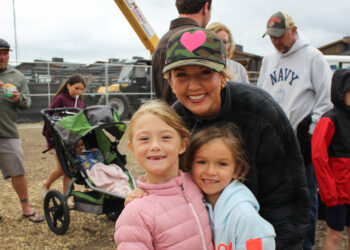By Kristin Gardner Blue Water Task Force
The back of the truck is crammed with snowshoes, ski poles, waders, a cooler, bottles, neoprene gloves, electronic devices, a pick ax, and a thermos of hot tea. These are the tools for a day collecting water quality data on the Gallatin River, as part of the Blue Water Task Force’s Community Water Quality Monitoring Program.
Water quality is an ecological indicator of our watersheds’ health, similar to drawing blood and running an analysis of cholesterol, blood counts or tryglycerides to glean perspective on human health. Under this program, BWTF has been collecting water quality data for 14 years, even during the winter.
Although winter monitoring presents challenges, it is critical because it reveals clues to the river’s relationship with the land, and vice versa. Much of this information is unavailable at other times of year when it’s more appealing to be poking around in the river.
Land influences are typically most visible now because winter streamflow and chemistry are mainly influenced by groundwater. There is minimal dilution from snowmelt, and algae is not yet consuming nutrients and diminishing their levels.
So out we go, trudging through deep snow, picking away enough ice to make a conduit to the river. Through a small hole in the ice, we measure water chemistry (temperature, pH, turbidity, E.coli, coliform, chloride, conductivity, total dissolved solids), and bring back samples to the lab to analyze nitrogen, E.coli and coliform levels.
We collect this information four times a year – in December, April, June and August. During the summer, we collect data on streamflow, aquatic insects and algae.
The BWTF stream data doesn’t sit on a shelf (or a website) and collect dust. Historically, a number of groups have used it to assess and track the health of the Gallatin River watershed. They include state and county agencies, university researchers, other watershed organizations, and Ophir School science teachers.
I was first introduced to BWTF and to Big Sky in 2005, in this very way. A Montana State University graduate student at the time, I was searching for a viable research question for my doctoral work in hydrology.
My fate changed when I threw together a plot of stream water nitrate values collected by the BWTF and others since 1971, alongside the number of residences in Big Sky during that time period. The two lines tracked each other almost perfectly, showing larger amounts of nitrate over time.
This simple plot was the catalyst that brought in more than $400,000 in state and federal grants to study nitrogen dynamics in the Big Sky area. This research resulted in numerous publications in peer reviewed science journals, shedding light on important questions in hydrology and stream biogeochemistry in mountain streams.
It also provided critical information for the state water quality planning process (Total Maximum Daily Load Program) in the Upper Gallatin. Without the information provided by the BWTF data, this research would likely never have materialized.
Currently, the BWTF monitoring data is being used to plan for and develop multiple projects to improve water quality and fish habitat. This will have long-term positive effects on the health of the river and on our community.
There still is much to learn about the Gallatin. As our community continues to grow and change, it will be critical to continue to assess and track the river’s health to protect one of our most treasured assets.
Volunteer for BWTF
The next scheduled BWTF Community Water Quality Monitoring is Friday, April 4. The information collected will be used to protect and keep local water resources clean and healthy, and you might even have fun and learn something at the same time.
“This is one of the most beautiful places in the country, perhaps the world,” said BWTF board member Ron Bowlin. “What a great place to be outdoors and contribute positively to our community… Volunteerism is the essence of our American culture and the seed of our greatness.”
Interested in volunteering for this event, or for one in June, September or December? Contact Kristin Gardner at (406) 993-2519 or kristin@bluewatertaskforce.org.
Kristin Gardner is Executive Director of the Blue Water Task Force in Big Sky. All BWTF data and associated reports are available for public viewing at bluewatertaskforce.org.













